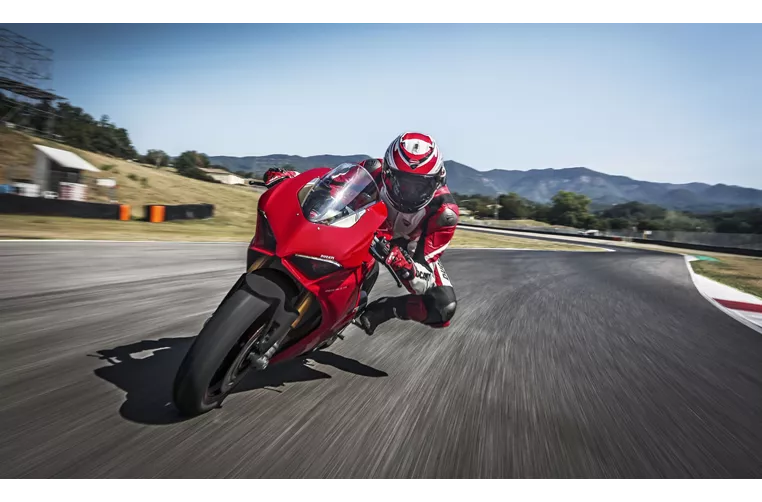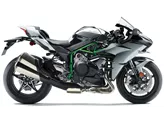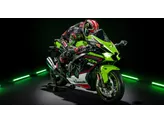Kawasaki Ninja H2 2015 vs. Ducati Panigale V4 S 2018

Kawasaki Ninja H2 2015

Ducati Panigale V4 S 2018
Overview - Kawasaki Ninja H2 2015 vs Ducati Panigale V4 S 2018
The Kawasaki Ninja H2 model year 2015 and the Ducati Panigale V4 S model year 2018 are both high-performance supersport motorcycles with impressive specifications.
In terms of engine and drive train, the Ninja H2 is equipped with an in-line, 4-cylinder engine with a displacement of 998cc. It produces 200 horsepower and 133.5 Nm of torque. On the other hand, the Panigale V4 S features a V4 engine with a displacement of 1103cc, delivering 214 horsepower and 124 Nm of torque. The Panigale V4 S has a higher compression ratio of 14 compared to the Ninja H2's 8.5. Both bikes have 4 valves per cylinder, but the Ninja H2 uses a DOHC system while the Panigale V4 S utilizes a Desmodromic system.
In terms of suspension, both motorcycles have a telescopic fork front suspension with compression, preload, and rebound adjustment. They also have a single swing arm rear suspension with the same adjustment options.
When it comes to the chassis, the Ninja H2 features a steel frame while the Panigale V4 S has an aluminum monocoque frame. The monocoque frame provides better rigidity and handling characteristics compared to the tubular steel frame.

Kawasaki Ninja H2 2015
In terms of braking, both motorcycles have double disk front brakes with radial technology. However, the Panigale V4 S also has monoblock technology, which provides even better braking performance.
In terms of dimensions and weights, the Ninja H2 has a wheelbase of 1455mm, seat height of 825mm, and a kerb weight of 238kg with ABS. It has a fuel tank capacity of 17 liters. On the other hand, the Panigale V4 S has a slightly longer wheelbase of 1469mm, a slightly higher seat height of 830mm, and a lighter kerb weight of 195kg with ABS. It has a slightly smaller fuel tank capacity of 16 liters.
In terms of strengths, the Ninja H2 is praised for its outstanding build quality, powerful engine with a mechanical turbocharger, excellent pull, acceleration, and speed, as well as its narrow seat that ensures safe standing for riders of all sizes. It also offers great stability, confidence-inspiring performance, strong brakes, and high-quality details.

Ducati Panigale V4 S 2018
The Panigale V4 S, on the other hand, is known for its dreambike image, excellent brakes, comfortable seating position for taller riders, impressive lean angle potential, leading electronics package, and finely controllable engine power. It is also praised for its ingenious handling, allowing riders to finish corners early and accelerate quickly.
In terms of weaknesses, the Ninja H2 is criticized for its response behavior in the transition from pushing mode to acceleration phase, as well as its understeer in fast bends. It may also be difficult for riders taller than 185cm to integrate their feet into the overall aerodynamic concept.
The Panigale V4 S has a few weaknesses, including a seat that warms up noticeably and can be uncomfortable in summer. The seat-tank combination also offers little grip in the braking zone. Additionally, the bike requires caution and discipline with tuning measures and seat position on fast and bumpy sections to maintain stability at the limit.
In conclusion, both the Kawasaki Ninja H2 2015 and the Ducati Panigale V4 S 2018 are high-performance supersport motorcycles with their own strengths and weaknesses. The Ninja H2 offers outstanding build quality, a powerful engine, and great stability, while the Panigale V4 S boasts a dreambike image, excellent brakes, and impressive handling. Riders should consider their preferences and riding style when choosing between these two models.
Technical Specifications Kawasaki Ninja H2 2015 compared to Ducati Panigale V4 S 2018
Pros and Cons in comparison
Pros and Cons in comparison
Kawasaki Ninja H2 2015

The Ninja H2 represents a milestone in motorbike history. It is not only packed with electronic innovations, but also offers completely new technologies in terms of engine construction and mechanics. This high-tech research object of a Japanese technology company is actually for sale and can also be ridden. Basically, it rides like a normal motorbike, only with considerably more power. At first, the engine response is a challenge, but speed freaks will find a way to ride and enjoy this fascinating motorbike.
Ducati Panigale V4 S 2018

The S version, on the other hand, is recommended for both road and racing riders. If the bike is ridden more ambitiously by a racer on the race track, the suspension will maintain its performance longer than with the basic version, whereby a slight adjustment of the front spring rate (for racers) is recommended. The lighter wheels have a noticeable effect on the handling. It is unbelievable to what a high level of innovation and technology in motorbike construction this bike has been raised. I have never experienced electronics that respond so sensitively.
Price Comparison Avarage Market Price Kawasaki Ninja H2 vs Ducati Panigale V4 S
There are a few key differences between a Kawasaki Ninja H2 2015 and a Ducati Panigale V4 S 2018. In terms of price, the actual average price of a Kawasaki Ninja H2 2015 is about 21% higher. A Kawasaki Ninja H2 2015 experiences a loss of 6,020 USD in one year and 5,130 USD in two years of ownership. This is offset by a loss of 1,920 USD and 2,680 USD for a Ducati Panigale V4 S 2018. Compared to Ducati Panigale V4 S 2018 there are less Kawasaki Ninja H2 2015 bikes available on the 1000PS.de Marketplace, specifically 4 compared to 5. It takes less time to sell a Ducati Panigale V4 S with 97 days compared to 153 days for the Kawasaki Ninja H2. Since model year 2015 1000PS.de editors have written 27 reviews for the Kawasaki Ninja H2 and 21 reviews for the Ducati Panigale V4 S since model year 2018. The first review for the Kawasaki Ninja H2 was published on 8/31/2014 and now has more than 5,600 views. This compares to more than 131,500 views for the first review on Ducati Panigale V4 S published on 11/5/2017.





















